- Home
- Encyclopedia
- John Campbell and The Invention of Wyoming
John Campbell and the Invention of Wyoming
Wyoming’s first governor was no longer quite young when he arrived in the brand-new territory, stepping off the train in a Cheyenne rainstorm. Unmarried, 33 years old, John A. Campbell was a short, handsome man, with hair a little thin on top and a thick beard below. President Ulysses S. Grant had appointed him governor just a few weeks earlier. Grant himself had been president just a few weeks longer than that.
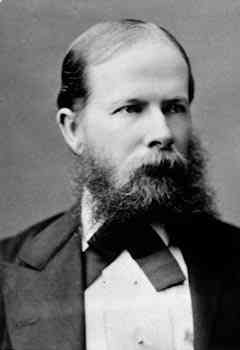
Like most of the men the new president was appointing to government jobs, Campbell had served on the Union side in the Civil War, part of that time on the staff of Maj. Gen. John M. Schofield. He had done well, entering the Army as a private and ending up a brevet brigadier general. Before the war he had worked as a printer and writer on a newspaper in Cleveland, Ohio.
After the war he stayed in the Army on Schofield’s staff, working in northern Virginia to get political systems set up and going again. Not only had the war killed hundreds of thousands of men, it had flattened crops, ruined businesses, and ended politics-as-usual across the South.
But the war had also freed the people who had previously been enslaved. With the conflict behind it, the nation quickly approved changes in the Constitution guaranteeing the right to vote to men of all colors. Campbell’s job included setting up elections and redrawing the boundaries of the areas in Virginia that sent representatives to the state legislature. To do so, he needed to know something about the countryside and population of each area. To do his job right, he had to make sure the freed slaves could in fact vote at the new elections.
Perhaps this work, reinventing politics in northern Virginia, had made him seem a likely choice for governor of Wyoming Territory. In Wyoming he would have to establish politics and government in a place where very little had existed before.
This would prove difficult. Much of the work might have gone more smoothly if the territory had had a stronger economy—and if Campbell himself had been a stronger leader. Still, he acted with real courage at some important moments, and those actions produced positive results when things might easily have turned out far worse.
A new territory
Congress had established the new Wyoming Territory in the summer of 1868, carving most of it from western parts of Dakota Territory and the rest from smaller slices of Utah and Idaho territories. Laramie County and Carter County (later Sweetwater County), for example, had already existed as part of Dakota Territory.
President Andrew Johnson, however, near the end of his term and dealing with a hostile Congress that was impeaching him, failed to win Congressional approval for any of his appointees to a new Wyoming government. The new president, Ulysses S. Grant, shortly after taking office in March 1869, appointed a slate of Wyoming territorial officers with Campbell as governor. Congress quickly confirmed the appointments.
Campbell arrived on May 7, 1869. Cheyenne then was still a drab, treeless place of shacks and thin-board buildings, with garbage blowing by and dogs running loose. He would normally have been expected to give a speech, perhaps from the platform at the rear of the train.
But the rain made that impossible, and anyway the governor wasn’t feeling well. The motion of the train may have made him nauseous. Later, some people sang songs for him. “Was serenaded at night,” he wrote in his diary, “but too sick to respond.”
With Campbell on the train were other territorial officers, also appointed by Grant: Campbell’s second-in-command, Territorial Secretary Edward M. Lee; the three judges who would run the territorial courts, John H. Howe, W.T. Jones and John W. Kingman; U.S. Attorney Joseph M. Carey, who would go on to a long career in Wyoming politics; and the head police officer for the territory, U.S. Marshal Church Howe.
Wyoming Territory had existed on paper before they came. But their arrival made it a real thing. Before then, such government as there was in the 1860s came from authorities in Salt Lake City, in Utah Territory, Lewiston in Idaho Territory and Yankton in Dakota Territory.
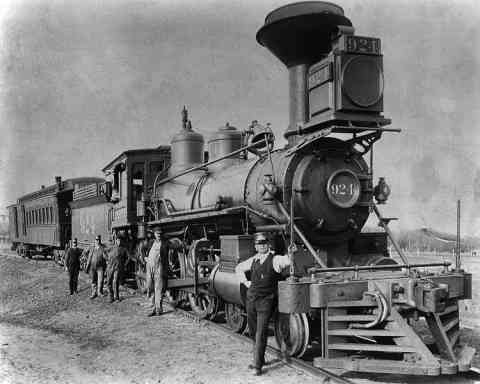
Only the building of the transcontinental Union Pacific Railroad had made creation of Wyoming Territory necessary at all. The railroad had begun building west from Omaha in 1867, crossed what’s now Wyoming in 1868 and in May 1869 linked up with the Central Pacific in Utah Territory to become the first transcontinental line.
As Campbell would note later, it was the first time in history that the coming of a railroad had preceded, not followed, settlement. And he knew how important the railroad was to the new territory. Just two days after he arrived in Cheyenne, he rode the railroad west to Utah to make sure Wyoming was represented at the famous golden spike ceremony marking the completion of the transcontinental road.
But because Campbell, Lee and the other new officials were appointed, not elected, the territory was more like a colony than a state. These new men did not know the people they had been sent to govern, and the people did not know them. Equally important, their jobs depended not on the votes of locals but on whether they could please their superiors in the Grant administration in distant Washington, D.C.
An indecisive president
President Abraham Lincoln had made Grant general of all the Union armies in 1864, and he earned a reputation as a great general. He was willing to make the horrible decision to send large numbers of men to their deaths in order to win battles, and so his armies won the war.
But the man who had been so clear-headed in war was uncertain in politics. Grant filled the national government with his Union Army friends and connections, yet apparently didn’t have the heart to be a tough boss when people didn’t do their jobs.
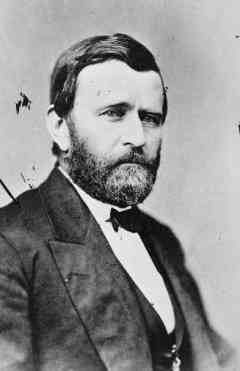
This mattered a great deal in Wyoming. Grant “exercised his patronage power”—his power to hire and fire members of his administration—“whimsically and indecisively,” historian Lewis Gould has written. “This policy created an atmosphere of uncertainty, which encouraged devious intrigues and treachery” inside his government.
Like the president, the new officers of Wyoming Territory, including Campbell and Lee, were Republicans. The Republican Party at the time was still the party of Lincoln—the party that had freed the slaves, opposed hard liquor, won the war and saved the Union. Now, after the war, the Republicans were becoming the party of business and property owners.
The Democrats, by contrast, had long been considered the party of small farmers, drinkers and the common man. During the Civil War, many northern Democrats had wanted to settle the conflict by negotiation rather than through fighting. Now they opposed votes for black people.
Like nearly all presidents, Grant used his patronage powers to his political advantage and to the advantage of his party. He appointed as many Republicans as possible because he realized that more Republicans in the territories and everywhere else would help him stay in power in Washington.
A new government
The first job facing Wyoming’s new officials was similar to the work Campbell had done in Virginia—drawing legislative districts and setting up elections. Since nearly all the 8,000 or so non-Indians in Wyoming lived along the railroad, the new Territory was divided into five counties, each with its own railroad town. Then as now, Cheyenne was in Laramie County; Laramie was in Albany County; Rawlins in Carbon County; Green River City, as it was called, was in Carter County, which was soon renamed Sweetwater County; and Bear River City, 10 miles southwest of what later became the town of Evanston, was in Uinta County.
The counties were huge. They ran all the way from the south border of the territory to the north. Each county, according to its population, would send representatives to the new territorial legislature in Cheyenne. The legislature would have thirteen representatives in its House, and nine councilors in its Council, essentially a Senate. And the whole territory would elect a delegate to the U.S. Congress who, once he got there, would be able to talk and persuade as he represented Wyoming, but not to vote. That right would only come with statehood.
A railroad in territorial politics
At that time, however, real power in Wyoming belonged not so much to any government as it did to the Union Pacific Railroad. The railroad was the largest private landowner in the territory and the largest non-government employer.
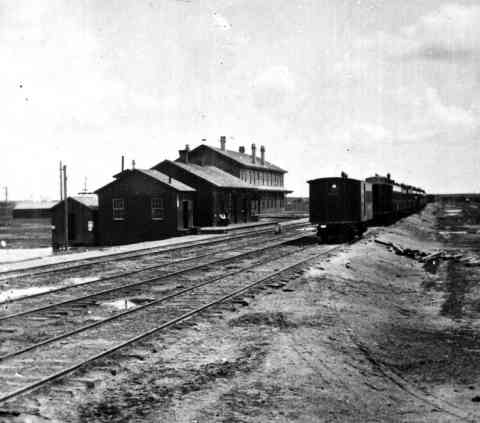
The railroad owned the towns, too. Anyone who wanted to start a store or build a house in town first had to buy the real estate from the railroad. However, Campbell and the other territorial officers had been in Cheyenne less than a month when Grenville Dodge, chief engineer for the Union Pacific, offered them each a free town lot.
“Dodge said the officers of the territory might each collect a lot in Cheyenne, and the R.R. Co. would donate it to them,” Campbell noted in his diary June 2. Whether this was meant as a gift, something more like a bribe, or something else, Campbell does not make clear in his diary. He also does not say whether he accepted it.
The first territorial elections were held Sept. 2, 1869. Stories circulated in the Republican papers that the Democrats were buying votes around Cheyenne. Whether they were or not, every man elected from the Territory—to the House, the Council, and the lone delegate to Congress—was a Democrat.
“Beaten at election,” Campbell wrote in his diary that day. Because he was an appointee, Campbell himself hadn’t been beaten, but the Republican Party in Wyoming had been whipped. The Grant government in Washington, Gould notes, began to look on Wyoming as a problem.
Because their jobs—and the money to run their Territorial government—depended on the good will of people in Washington, Campbell and the others always had to work hard to stay on good terms with the nation’s capital. Campbell spent months each year in the East visiting politicians, generals and railroad tycoons.
Yet as time went on, Gould has carefully shown, a kind of free-for-all developed, with various Wyoming Republicans working behind each others’ backs to blacken the reputations of their rivals as perceived by the higher-ups in Washington.
When the people elected a Republican delegate to Congress a year later, in 1870, it was a rare success for Campbell’s bruised political image back East.
As for the railroad, its officials assumed they had the right to steer Wyoming politics. But when they told Campbell they would be selecting the Republican candidate for Congress in 1870, the governor stood up to them.
He wrote Grenville Dodge on July 13, 1870 that he counted on the railroad’s support for the Republicans no matter who the candidate might be. Dodge backed off, agreeing the railroad would stay neutral. In the future, railroad officials were more careful to cover their political tracks.
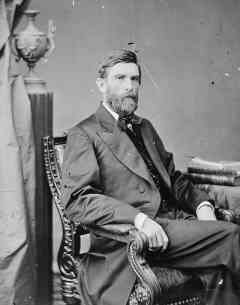
Even though the Wyoming Republicans slowly began winning seats in the territorial legislature, bickering among them just got worse. By the end of 1870, the territorial officers had split into two factions, with Campbell, the editor of the Laramie newspaper and their allies on one side and the U.S. marshal and the new territorial secretary, who also edited one of the Cheyenne papers, on the other.
President Grant’s decisions made the problems even worse. When he heard complaints from one side, he fired men, and then reinstated them when he heard howls from the other side. All the officials in the territorial government had to spend a great deal of time keeping an eye on Washington, which left little time to get much else done of value in the territory.
A single-industry economy
The real problem was deeper. Wyoming Territory was simply too poor. Some gold mines had boomed briefly near South Pass but played out by 1870. Afterward, Wyoming had almost no gold, silver or copper mines like the ones that built the wealth of California, Utah, Idaho, Colorado and Montana in the middle and late 1800s. It also had almost no farmers growing crops, like the ones that steadied the wealth of Nebraska, Kansas, eastern Colorado and the Dakotas during the same years.
Despite Campbell’s response to Dodge about meddling in politics, the Territory was dependent upon a single industry—the railroad—and upon the federal government to keep money flowing in. All through the 1870s, about an eighth of all workers held railroad jobs and about a fourth held federal jobs. These were mostly soldiers, stationed at forts to be on alert for Indian attacks.
Given the weak economy and the importance to it of various kinds of federal subsidy and support, Gould notes, it seems almost inevitable in retrospect that keeping the federal funds flowing would become the main focus of territorial politics.
As for Campbell, he was reappointed in 1874. In 1875, Grant offered him a middle-level job in the U.S. State Department. He accepted and left Wyoming Territory, where, although he had not achieved as much politically as he had perhaps hoped, he had left behind a structure that would allow for a steadier kind of government, once politicians became more skillful.
And at least twice—once to the railroad and once to the Legislature when it tried to repeal votes for women—he had the nerve to stand up and do the right thing, without knowing if it would hurt him or not. And that counts for a lot.
Resources
Primary Sources
- Campbell, John A. “Diary, 1869-1875,” Wyoming Annals, vol. 10 (1938). Publication was spread over four issues of the magazine. See vol. 10, no. 1, pp. 5-8; vol. 10, no. 2, pp. 59-78; vol. 10 no. 3, pp. 120-142, and vol. 10, no. 4, pp. 155-185, accessed March 23, 2015, at https://archive.org/details/annalsofwyom10141938wyom. Campbell’s diary entries during his years as governor were always short. He noted down places he visited and people he met, but recorded few thoughts, feelings or descriptions. The note about Dodge’s offer of the town lots is on p. 10 of vol. 10, no. 1.
Secondary sources
- Gould, Lewis. Wyoming: A Political History, 1868-1896. New Haven: Yale University Press, 1968. See especially the first two chapters, “A New Territory,” and “The Campbell Era,” pp. 1-48, which include shrewd insights into the political results in Wyoming of a weak territorial economy and a weak administration in Washington. High Plains Publishing Company in Worland, Wyo. republished this book in 1989 under a new title: Wyoming, from Territory to Statehood, with a new preface by the author.
- Larson, T.A., History of Wyoming. Lincoln: University of Nebraska Press, 1965. 64-78.
- Wyoming State Archives. “John A. Campbell (R).” accessed Jan. 15, 2020 at https://wyomingbluebook.wiki.zoho.com/John-A-Campbell.html?pid=5433797000000005067&opname=John-A.-Campbell. Includes a brief biography of Campbell as well as a guide to the State Archives’ collection of Campbell’s papers from his time as territorial governor.
Illustrations
- The photo of John Campbell is from the Wyoming State Archives. Used with permission and thanks.
- The Wikipedia photo of the Union Pacific locomotive, the Library of Congress photo of Ulysses S. Grant, the 1869 U.S. Geological Survey photo of the Cheyenne depot and railroad hotel and the Wikipedia photo of Grenville Dodge are all used with thanks.
